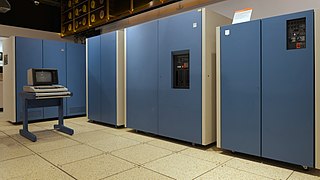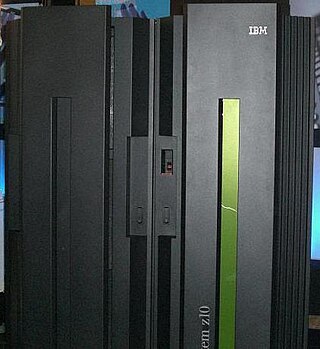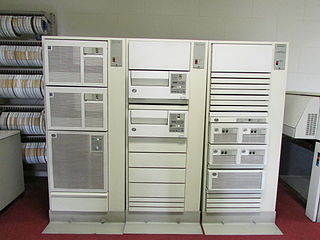
AIX is a series of proprietary Unix operating systems developed and sold by IBM for several of its computer platforms.

The IBM System/370 (S/370) is a range of IBM mainframe computers announced as the successors to the System/360 family on June 30, 1970. The series mostly maintains backward compatibility with the S/360, allowing an easy migration path for customers; this, plus improved performance, were the dominant themes of the product announcement.

VM is a family of IBM virtual machine operating systems used on IBM mainframes System/370, System/390, zSeries, System z and compatible systems, including the Hercules emulator for personal computers.

Amdahl Corporation was an information technology company which specialized in IBM mainframe-compatible computer products, some of which were regarded as supercomputers competing with those from Cray Research. Founded in 1970 by Gene Amdahl, a former IBM computer engineer best known as chief architect of System/360, it has been a wholly owned subsidiary of Fujitsu since 1997. The company was located in Sunnyvale, California.

The IBM 4300 series are mid-range systems compatible with System/370 that were sold from 1979 through 1992. They featured modest electrical and cooling requirements, and thus did not require a data center environment. They had a disruptive effect on the market, allowing customers to provide internal IBM computing services at a cost point lower than commercial time-sharing services. All 4300 processors used a 3278-2A, 3279-C or 3205 display console rather than a 3210 or 3215 keyboard/printer console.
A hypervisor, also known as a virtual machine monitor (VMM) or virtualizer, is a type of computer software, firmware or hardware that creates and runs virtual machines. A computer on which a hypervisor runs one or more virtual machines is called a host machine, and each virtual machine is called a guest machine. The hypervisor presents the guest operating systems with a virtual operating platform and manages the execution of the guest operating systems. Unlike an emulator, the guest executes most instructions on the native hardware. Multiple instances of a variety of operating systems may share the virtualized hardware resources: for example, Linux, Windows, and macOS instances can all run on a single physical x86 machine. This contrasts with operating-system–level virtualization, where all instances must share a single kernel, though the guest operating systems can differ in user space, such as different Linux distributions with the same kernel.
In computing, a Parallel Sysplex is a cluster of IBM mainframes acting together as a single system image with z/OS. Used for disaster recovery, Parallel Sysplex combines data sharing and parallel computing to allow a cluster of up to 32 systems to share a workload for high performance and high availability.
A logical partition (LPAR) is a subset of a computer's hardware resources, virtualized as a separate computer. In effect, a physical machine can be partitioned into multiple logical partitions, each hosting a separate instance of an operating system.

IBM System z9 is a line of IBM mainframe computers. The first models were available on September 16, 2005. The System z9 also marks the end of the previously used eServer zSeries naming convention. It was also the last mainframe computer that NASA ever used.
IBM S/390 Multiprise was a short-lived series of small, compact, entry-level mainframes.

IBM Z is a family name used by IBM for all of its z/Architecture mainframe computers. In July 2017, with another generation of products, the official family was changed to IBM Z from IBM z Systems; the IBM Z family now includes the newest model, the IBM z16, as well as the z15, the z14, and the z13, the IBM zEnterprise models, the IBM System z10 models, the IBM System z9 models and IBM eServer zSeries models.

IBM System z10 is a line of IBM mainframes. The z10 Enterprise Class (EC) was announced on February 26, 2008. On October 21, 2008, IBM announced the z10 Business Class (BC), a scaled-down version of the z10 EC. The System z10 represents the first model family powered by the z10 quad core processing engine. Its successors are the zEnterprise System models introduced in 2010 and 2012.
The VAX 9000 is a discontinued family of mainframes developed and manufactured by Digital Equipment Corporation (DEC) using custom ECL-based processors implementing the VAX instruction set architecture (ISA). Equipped with optional vector processors, they were marketed into the supercomputer space as well. As with other VAX systems, they were sold with either the VMS or Ultrix operating systems.
The Input/Output Configuration Program is a program on IBM mainframes.
Linux on IBM Z or Linux on zSystems is the collective term for the Linux operating system compiled to run on IBM mainframes, especially IBM Z / IBM zSystems and IBM LinuxONE servers. Similar terms which imply the same meaning are Linux/390, Linux/390x, etc. The three Linux distributions certified for usage on the IBM Z hardware platform are Red Hat Enterprise Linux, SUSE Linux Enterprise Server, and Ubuntu.

The IBM 9370 systems are "baby mainframe" midrange computers, released 1986 at the very low end of, and compatible with System/370. The media of the day, referring to the VAX systems manufactured by Digital Equipment Corporation (DEC), carried IBM's alleged "VAX Killer" phrase, albeit often skeptically.

The IBM 308X is a line of mainframe computers, of which the first model, the Model 3081 Processor Complex, was introduced November 12, 1980. It consisted of a 3081 Processor Unit with supporting units.

The IBM System/390 is a discontinued mainframe product family implementing ESA/390, the fifth generation of the System/360 instruction set architecture. The first computers to use the ESA/390 were the Enterprise System/9000 (ES/9000) family, which were introduced in 1990. These were followed by the 9672, Multiprise, and Integrated Server families of System/390 in 1994–1999, using CMOS microprocessors. The ESA/390 succeeded ESA/370, used in the Enhanced 3090 and 4381 "E" models, and the System/370 architecture last used in the IBM 9370 low-end mainframe. ESA/390 was succeeded by the 64-bit z/Architecture in 2000.
IBM Enterprise Systems Architecture is an instruction set architecture introduced by IBM as ESA/370 in 1988. It is based on the IBM System/370-XA architecture.











